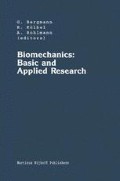Abstract
The shape of most of the intramedullary and interlocking nails commonly used has been determined empirically as a segment of a circle. The radius of curvature of the Küntscher nail, e.g., has a length of 3500 mm, the Aesculap-Küntscher 3500 mm, the Grosse-Kempf 3000 mm, the AO 4000 mm, and the Klemm-Schellmann 3500 mm. Despite the fact that all these implants do not match the geometry of the femoral cavity, the application of “physiologically” curved nails is reported by two groups (11,14,22). In clinical use, the exact location of the point of insertion, axial malalignement, additional comminution of the fractured area or perforation of the distal metaphysis are related to a misfit between the geometry of the femoral cavity and the shape of the implant (4,10,11,12,15,16,20,21). Although the anatomy of the femur has been studied extensively (5,8,9,13,17), limited data is available with respect to the geometrical properties pertinent for intramedullary nailing of this bone. Two groups (11,14,22 and Winquist personal communication) determined the radius of curvature of the femur in the antero-posterior plane by sagittal x-rays.
Access this chapter
Tax calculation will be finalised at checkout
Purchases are for personal use only
Preview
Unable to display preview. Download preview PDF.
References
Batory, I.: Ätiologie der pathologischen Veränderungen des kindlichen Hüftgelenkes. Bücherei des Orthopäden, Enke Verlag, Stuttgart, 32: 25–27, 1983.
Chung, S.M.K.: The arterial supply of the developing proximal end of the human femur. J. Bone Joint Surg., 58A: 961–970, 1976.
Crock, H.V.: A revision of the anatomy of the arteries supplying the upper end of the human femur. J. Anat., 99 (1): 77–88, 1965
Hansen, S.T., Winquist, R.A.: Closed intramedullary nailing of the femur. Clin. Orthop. 138: 56–61, 1979.
Holtby, J.R.D.: Some indices and measurements of the modern femur. J. Anat. Physiol. LII. (Third ser. Vol VIII), 363–379, 1918.
Küntscher, G.: Die Marknagelung von Knochenbrüchen. Arch. klin. Chir. 200: 443–455, 1940.
von Lanz, T., Wachsmuth, W.: Praktische Anatomie, 1/4 Bein und Statik. Springer Verlag, Berlin/Heidelberg 1972.
Martin, R.: Lehrbuch der Anthropologie. Osteologie. G. Fischer, Jena: 995, 1038, 1043–1047, 1141–1143, 1928.
Merkel, F., Bonnet, R.: Anatomie und Entwicklungsgeschichte des Femur. In: Anatomische Hefte. J.F. Bergmann, Wiesbaden. 610, 623–625, 1901.
Müller, M.E., Allgöwer, M., Schneider, R., Willenegger, H.: Manual der Osteosynthese. Springer Verlag, Berlin, 104–119, 1969.
Onoue, Y., Sunami, Y., Fujiwara, T., Sadakane, T., Yasuda, S.: Treatment of the femoral shaft fracture with a curved heat-treated COP clover-leaf nail. International Orthopaedics (SICOT) 3: 203–210, 1979.
Pelzl, H.: Hüftnekrose nach Femurschaftnagelung. Zbl. Chir. 95: 202–207, 1970.
Parsons, F.G.: The characters of the english thigh-bone. J. Anat. Physiol. XLVIII. (Third ser. Vol IX) 238–267, 1914.
Sadakane, T., Nagano, K., Onoue, Y., Sunami, Y., Engel-hardt, P.: Anatomische und bipmechanische Untersuchungen zur Femurmarknagelung. Arch. Orthop. Traum. Surg. 91: 31–37, 1978.
Raaymakers, E.L.F.B., Marti, R.K.: Spätkomplikationen nach Marknagelung am Oberschenkel. Hefte zur Unfallheilkunde 158: 192–195, 1982.
Reinders, J., Mockwitz, J.:Technical faults and complications in interlocking nailing of femoral and tibial fractures. Acta Orthop. Belg. Tome 50, Fasc. 5: 577–590, 1984.
Ruff, C.B., Hayes, W.C.:Cross-sectional geometry of Pecos Pueblo femora and tibiae. A biomechanical investigation I/II. Amer. J. Phys. Anthrop. 60: 359–381, 383–400, 1983.
Ryan, J.R., Rowe, D.E., Salciccioli, G.G.: Prophylactical internal fixation of the femur for neoplastic lesions. J. Bone Joint Surg. 58-A(8), 1071–1074, 1976.
Tencer A.F., Sherman, M.C., Johnson, K.D.: Biomechanical factors affecting fracture stability and femoral bursting in closed intramedullary rod fixation of femur fractures. J. Biomech. Engineering, 107: 104–111, 1985.
Trueta, J.: The normal vascular anatomy of the femoral head in adult man. J.Bone Joint Surg. 35B: 442–461, 1953.
Weiler, S., Renne, J.: Grundsätzliche Fehler und Komplikationsmöglichkeiten der Marknagelung. Chirurg, 44: 533–538, 1979.
Winquist, R.A., Hansen, S.T., Clawson, D.K.: Closed intramedullary nailing of femoral fractures. J. Bone Joint Surg., 66-A(4), 529–539, 1984.
Author information
Authors and Affiliations
Editor information
Editors and Affiliations
Rights and permissions
Copyright information
© 1987 Martinus Nijhoff Publishers, Dordrecht
About this chapter
Cite this chapter
Zuber, K., Eulenberger, J., Schneider, E., Perren, S.M. (1987). Anatomical Curvature of the Femoral Medullary Canal for Intramedullary Rodding. In: Bergmann, G., Kölbel, R., Rohlmann, A. (eds) Biomechanics: Basic and Applied Research. Developments in Biomechanics, vol 3. Springer, Dordrecht. https://doi.org/10.1007/978-94-009-3355-2_58
Download citation
DOI: https://doi.org/10.1007/978-94-009-3355-2_58
Publisher Name: Springer, Dordrecht
Print ISBN: 978-94-010-8007-1
Online ISBN: 978-94-009-3355-2
eBook Packages: Springer Book Archive

